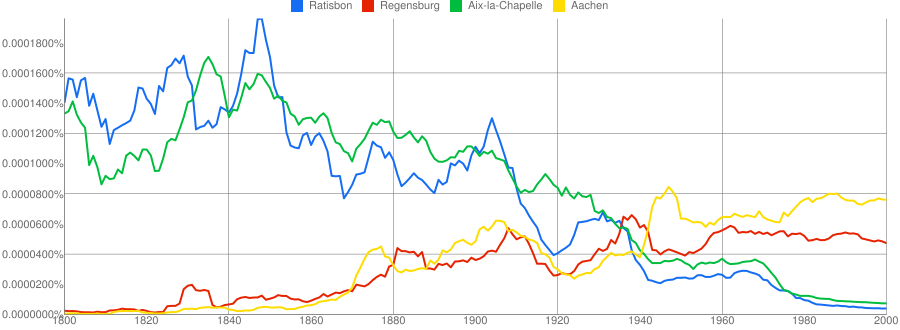There is no rule; this is a matter of style. Observe the discipline of your editor, publication, or organization, or in the absence of a house style, adhere to the guidance of your preferred style manualstyle manual.
Broadly speaking, the purpose of a location name, especially in a citation, is to allow the reader to recognize a location— not to win some sort of game of maximum faithfulness to endonyms. You already understand this. Using Córdoba for Cordova may go unnoticed, whereas Krung Thep in place of Bangkok would only serve to complicate and confuse.
Gallic names for central European locations were once standard in English. Some, like Cologne and Nuremberg, have persisted, but others been overtaken by the native German forms:
Moreover, you not only need to worry about which name your audience is more familiar with, but with any political implications of choosing one name over another— Derry or Londonderry? Pretoria or Tshwane? To avoid controversy as well as maintain consistency, then you may wish to choose some external reference or authority for geographic place names. The Associated Press Stylebook, for example, stipulates
For foreign place names, use the primary spelling in Webster's New World College Dictionary. If it has no entry, follow the National Geographic Atlas of the World.
The Chicago Manual of Style Q&A similarly suggests
[If there is disagreement about the spelling of proper nouns:] Agree on (or dictate) a specific reference work (such as a dictionary or encyclopedia of place-names) as a default. Negotiate a list of exceptions from each author and add them to your style sheet.
The Q&A notes more generally,
In the books that we publish, we depend on our authors to understand their audience and to style names accordingly. If the book is for a general audience, then names will probably appear in a form familiar to English-speaking readers. If the subject of the book is more narrowly defined and will be read by specialist scholars, the author might prefer to use the original-language names. Sometimes an author writing for a general audience will wish to educate readers by using the original names, but will introduce them by popular name. Merriam-Webster’s Biographical Dictionary is a good source for variations on names.
These are American style guides, and so they name American references; others may be more appropriate for other audiences. But ultimately, you are the one who must draw the line; there are too many names of too many places for any one references to dictate every case. As the CMOS Q&A notes elsewhere,
[If a convention is in transition or otherwise uncertain:] Styles that are in transition should be applied (or not) with the particular academic discipline, author preference, the document’s content, the readers, the likely longevity of the text, and any number of other factors in mind. A ruling from a style manual would only result in inappropriate enforcement. I’m sure you can see my point: these kinds of editorial decisions are best made by people like you and the writer, who are in a position to judge from experience.

